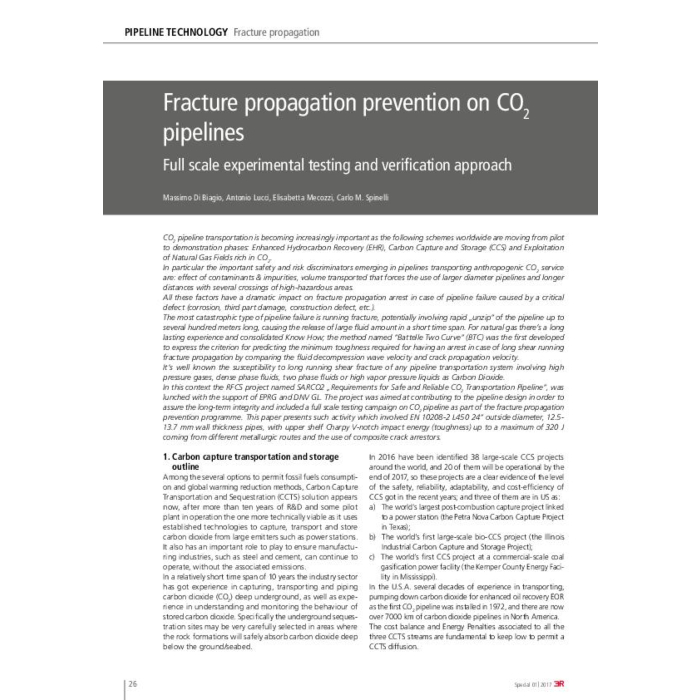Fracture propagation prevention on CO2 pipelines
4,90 €
Auf Lager
Artikelnummer
01252_2017_SP1_01
Full scale experimental testing and verification approach
CO2 pipeline transportation is becoming increasingly important as the following schemes worldwide are moving from pilot to demonstration phases: Enhanced Hydrocarbon Recovery (EHR), Carbon Capture and Storage (CCS) and Exploitation of Natural Gas Fields rich in CO2. In particular the important safety and risk discriminators emerging in pipelines transporting anthropogenic CO2 service are: effect of contaminants & impurities, volume transported that forces the use of larger diameter pipelines and longer distances with several crossings of high-hazardous areas. All these factors have a dramatic impact on fracture propagation arrest in case of pipeline failure caused by a critical defect (corrosion, third part damage, construction defect, etc.). The most catastrophic type of pipeline failure is running fracture, potentially involving rapid „unzip” of the pipeline up to several hundred meters long, causing the release of large fluid amount in a short time span. For natural gas there’s a long lasting experience and consolidated Know How; the method named “Battelle Two Curve” (BTC) was the first developed to express the criterion for predicting the minimum toughness required for having an arrest in case of long shear running fracture propagation by comparing the fluid decompression wave velocity and crack propagation velocity. It’s well known the susceptibility to long running shear fracture of any pipeline transportation system involving high pressure gases, dense phase fluids, two phase fluids or high vapor pressure liquids as Carbon Dioxide. In this context the RFCS project named SARCO2 „Requirements for Safe and Reliable CO2 Transportation Pipeline”, was lunched with the support of EPRG and DNV GL. The project was aimed at contributing to the pipeline design in order to assure the long-term integrity and included a full scale testing campaign on CO2 pipeline as part of the fracture propagation prevention programme. This paper presents such activity which involved EN 10208-2 L450 24” outside diameter, 12.5- 13.7 mm wall thickness pipes, with upper shelf Charpy V-notch impact energy (toughness) up to a maximum of 320 J coming from different metallurgic routes and the use of composite crack arrestors.
| Autoren | Massimo Di Biagio / Antonio Lucci / Elisabetta Mecozzi / Carlo M. Spinelli |
|---|---|
| Erscheinungsdatum | 01.01.1970 |
| Format | |
| Zeitschrift | 3R - Special 1 2017 |
| Verlag | Vulkan-Verlag GmbH |
| Seitenzahl | 12 |
| Titel | Fracture propagation prevention on CO2 pipelines |
| Untertitel | Full scale experimental testing and verification approach |
| Beschreibung | CO2 pipeline transportation is becoming increasingly important as the following schemes worldwide are moving from pilot to demonstration phases: Enhanced Hydrocarbon Recovery (EHR), Carbon Capture and Storage (CCS) and Exploitation of Natural Gas Fields rich in CO2. In particular the important safety and risk discriminators emerging in pipelines transporting anthropogenic CO2 service are: effect of contaminants & impurities, volume transported that forces the use of larger diameter pipelines and longer distances with several crossings of high-hazardous areas. All these factors have a dramatic impact on fracture propagation arrest in case of pipeline failure caused by a critical defect (corrosion, third part damage, construction defect, etc.). The most catastrophic type of pipeline failure is running fracture, potentially involving rapid „unzip” of the pipeline up to several hundred meters long, causing the release of large fluid amount in a short time span. For natural gas there’s a long lasting experience and consolidated Know How; the method named “Battelle Two Curve” (BTC) was the first developed to express the criterion for predicting the minimum toughness required for having an arrest in case of long shear running fracture propagation by comparing the fluid decompression wave velocity and crack propagation velocity. It’s well known the susceptibility to long running shear fracture of any pipeline transportation system involving high pressure gases, dense phase fluids, two phase fluids or high vapor pressure liquids as Carbon Dioxide. In this context the RFCS project named SARCO2 „Requirements for Safe and Reliable CO2 Transportation Pipeline”, was lunched with the support of EPRG and DNV GL. The project was aimed at contributing to the pipeline design in order to assure the long-term integrity and included a full scale testing campaign on CO2 pipeline as part of the fracture propagation prevention programme. This paper presents such activity which involved EN 10208-2 L450 24” outside diameter, 12.5- 13.7 mm wall thickness pipes, with upper shelf Charpy V-notch impact energy (toughness) up to a maximum of 320 J coming from different metallurgic routes and the use of composite crack arrestors. |
Eigene Bewertung schreiben


